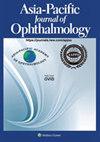Controversies, consensuses and guidelines on Small Incision Lenticule Extraction (SMILE) by the Academy of Asia-Pacific Professors of Ophthalmology (AAPPO) and the Asia-Pacific Myopia Society (APMS)
IF 4.5
3区 医学
Q1 OPHTHALMOLOGY
引用次数: 0
Abstract
Small incision lenticule extraction (SMILE) surgery was developed in 2008 as an extension of the femtosecond lenticule extraction procedure. Over the years, SMILE has become a highly popular laser refractive surgery offering a minimally invasive alternative to LASIK for correcting myopia and myopic astigmatism. Despite its benefits such as a flapless femtosecond laser procedure with reduced corneal nerve disruption, the procedure’s relative novelty necessitates standardization. Given the myriads of emerging information and variability, a panel of 22 international experts is formed by the Asia Pacific Myopic Society (APMS) and the Academy of Asia-Pacific Professors of Ophthalmology (AAPPO) to explore the controversy and to work out a consensus on SMILE. This consensus manuscript arises from a systematic exploration of current literature and is supported by the collective insights of international experts in the field of refractive surgery. The panel convened to review the issues, engage in discussion, develop proposals, and vote to establish consensus across four areas: 1) preoperative assessment, 2) preoperative surgical planning, 3) intraoperative considerations, and 4) postoperative management in a five-point Likert scale (strongly agree, agree, neutral, disagree and strongly disagree). Consensus was achieved when at least 75 % of the experts had voted for “strongly agree” or “agree” on the consensus statement concerned. 63 consensus statements were discussed, with 51 (81.0 %) statements reaching consensus. By establishing standardized consensus, this paper aims to reduce variability and enhance predictability and safety in refractive outcomes. Ongoing research is encouraged on issues where consensus could not be reached among the international panel of experts (IPE).
亚太眼科教授学会(AAPPO)和亚太近视学会(APMS)关于小切口晶状体摘除(SMILE)的争议与共识。
小切口晶状体取出术(SMILE)是在2008年发展起来的,是飞秒晶状体取出术的延伸。多年来,SMILE已经成为一种非常受欢迎的激光屈光手术,为矫正近视和近视散光提供了一种微创替代LASIK。尽管它的优点是无皮瓣飞秒激光手术减少了角膜神经的破坏,但该手术相对新颖,需要标准化。鉴于大量新出现的信息和可变性,亚太近视学会(APMS)和亚太眼科教授学会(AAPPO)组成了一个由22名国际专家组成的小组,探讨争议并就SMILE达成共识。这份共识稿源于对当前文献的系统探索,并得到了屈光手术领域国际专家的集体见解的支持。专家组召开会议审查问题,参与讨论,制定建议,并通过投票在四个方面达成共识:1)术前评估,2)术前手术计划,3)术中考虑,4)术后管理(李克特五点量表(强烈同意,同意,中立,不同意和强烈不同意)。当至少75%的专家对有关的共识声明投了“强烈同意”或“同意”票时,达成共识。讨论了63项共识声明,达成共识的声明51项(81.0%)。通过建立标准化的共识,本文旨在减少可变性,提高屈光结果的可预测性和安全性。鼓励对国际专家小组(IPE)无法达成共识的问题进行持续研究。
本文章由计算机程序翻译,如有差异,请以英文原文为准。
求助全文
约1分钟内获得全文
求助全文
来源期刊

Asia-Pacific Journal of Ophthalmology
OPHTHALMOLOGY-
CiteScore
8.10
自引率
18.20%
发文量
197
审稿时长
6 weeks
期刊介绍:
The Asia-Pacific Journal of Ophthalmology, a bimonthly, peer-reviewed online scientific publication, is an official publication of the Asia-Pacific Academy of Ophthalmology (APAO), a supranational organization which is committed to research, training, learning, publication and knowledge and skill transfers in ophthalmology and visual sciences. The Asia-Pacific Journal of Ophthalmology welcomes review articles on currently hot topics, original, previously unpublished manuscripts describing clinical investigations, clinical observations and clinically relevant laboratory investigations, as well as .perspectives containing personal viewpoints on topics with broad interests. Editorials are published by invitation only. Case reports are generally not considered. The Asia-Pacific Journal of Ophthalmology covers 16 subspecialties and is freely circulated among individual members of the APAO’s member societies, which amounts to a potential readership of over 50,000.
 求助内容:
求助内容: 应助结果提醒方式:
应助结果提醒方式:


